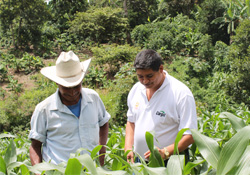Farming for the Future in Honduras
How a Cargill and CARE partnership is helping Honduran farmers improve upon a difficult past
November 13, 2015
The future is now for the 3,000 Honduran families participating in the Nutriendo el Futuro (Nourishing the Future) program. Six years into the program, which was designed to empower local communities to combat poverty and food security, farmers and national media are reporting impressive results.
"Before joining this project, we worked the land based on what our ancestors taught us,” said farmer Nulfo Nunez, who produces beans in the El Pino Community of Villanueva. “Now we have seen a huge change in the quantity and quality of the crop."
Once considered “the breadbasket of Central America,” the export-driven economy of Honduras has struggled since its heyday in the 1960s due to environmental and political challenges. Weather events have made the water supply unreliable for farming, and political upheaval has put a strain on development. An estimated 60 percent of Hondurans suffer from hunger and malnutrition.
 In Central America, Cargill launched the “Nutriendo el Futuro” intiative to help break the cycle of poverty. Included in that is Cargill’s longstanding partnership with CARE, a leading humanitarian organization fighting global poverty.
In Central America, Cargill launched the “Nutriendo el Futuro” intiative to help break the cycle of poverty. Included in that is Cargill’s longstanding partnership with CARE, a leading humanitarian organization fighting global poverty. The partnership focuses on 14 rural and suburban communities in the departments of Cortes and Comayagua, which have recently experienced extreme dryness and drought.
In Central America, Cargill launched the “Nutriendo el Futuro” intiative to help break the cycle of poverty. Included in that is Cargill’s longstanding partnership with CARE, a leading humanitarian organization fighting global poverty.
In Central America, Cargill launched the “Nutriendo el Futuro” intiative to help break the cycle of poverty. Included in that is Cargill’s longstanding partnership with CARE, a leading humanitarian organization fighting global poverty. The partnership focuses on 14 rural and suburban communities in the departments of Cortes and Comayagua, which have recently experienced extreme dryness and drought.
“The Niño Phenomenon is bringing a long-term summer, and many months without any rain,” said Liliana Barahona, coordinator of social responsibility for Cargill in Honduras. “So farmers are getting the resources they need to adapt.”
The program has established demo plots, provided farmer training, and supported food safety/nutrition awareness initiatives. Participating farmers dedicate 70 percent of their production to feeding their families, and their surplus, about 30 percent, is sold.
Now, yields are increasing by threefold and more. In 86 hectares of Villanueva, Cortes, 9,000 quintals of white maize and 2,000 quintals of red beans are being produced. A quintal is the equivalent of about 3.5 bushels.
"Before, we harvested only 10 to 12 bushels per acre. Now, we harvest more than 30 quintals, and every stalk of corn comes to have three ears,” said Fausto Diaz, president of the Farmers Association in the community of El Zapotal, in Santa Cruz de Yojoa. He was interviewed by the national news organization La Prensa.
A key strategy of the program has been a holistic and integrated approach, involving key players from all levels of the communities. Community leaders formally committed to participating in the program, and to strengthening their vision to work toward improved food safety and nutrition. Teachers, volunteers and municipal technical staff are also involved. They share information on cultivation and production techniques, such as crop rotation, and teach schoolchildren about nutrition.
Farmers have also formed coalitions through the program, which has helped them access better seed, better fertilizers, and better agricultural technology.
“We close the cycle by helping finance the purchase of inputs, which are so important,” said Barahona, “Moreover, we show the way for more producers to join.”
New cultivation techniques and marketing skills have helped farmers command higher prices. The program also offers agricultural insurance to help farmers protect their crops from drought or flooding.
¨With Nourishing the Future we are creating and leaving a success model that can be replicated by any other public or private actor in other countries,” Barahona said. “This translates, in actions, our Cargill promise of making our communities thrive.”
